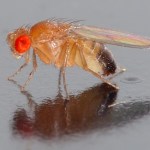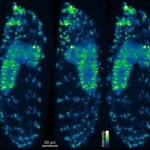Drosophila
There is some interesting new research out on the Asian Fruit Fly, Drosophila suzukii.
The short version: This sort of fruit fly ruins fruit crops because it prefers to, and is able to, lay its eggs on harder, firmer, unrotten, and, essentially, ripe fruit, thus ruining it. Regular fruit flies focus on rotten fruit such as groundfall.
The Asian fruit fly manages this because of slightly different fruit detection mechanisms, though some of the details of this are not yet known. In the future, it is hoped that the exact chemical used by this fly to find its target ripe fruit can be…
Image by Botaurus - Wikimedia commons
A changing climate has the potential to greatly impact ectotherms, which depend on the environment to regulate their own body temperatures. In a new study published in the American Journal of Physiology- Regulatory, Integrative and Comparative Physiology, researchers were curious how exposure to varying temperatures would affect developing ectotherms. They answered this question using Drosophila melanogaster, commonly known as fruit flies. They exposed freshly laid eggs to ten different temperatures ranging from 12 to 32°C, the upper and…
"Drosophila melanogaster - side (aka)" by André Karwath aka Aka - Own work. Licensed under CC BY-SA 2.5 via Wikimedia Commons -
Researchers at the University of California at San Diego were interested in understanding how exposure to low oxygen concentrations impact heart function. For humans low oxygen delivery to the heart can occur with exposure to high altitude, respiratory diseases, inflammation, blood clots and during a heart attack when there is inadequate blood flow to the heart muscle. The results of their study were recently published in the American Journal…
The Arizona Physiological Society held their 8th annual conference Nov 13-14 at Midwestern University in Glendale. This was a great meeting for comparative physiologists!
Here are some comparative physiology highlights from the meeting:
The 2015 Keynote Speaker was Dr. Andrew Biewener (Harvard University) who spoke about "How do running animals acheive stability? The neuromechanical control of rapid locomotion." In his talk he focused on understanding how Guinea fowl avoid tripping when running really fast over uneven surfaces.
The 2015 Arizona Distinguished Lecture was given by Dr.…
A still shot from the 3D-IsoView microscope shows neural activity within a Drosophila larva detected with fluorescent indicators. Image courtesy of Keller Lab, HHMI/Janelia Research Campus
A new kind of three-dimensional technology, called IsoView, allows researchers to view biological processes within nontransparent animals that are rather large by microscopy standards such as the drosophila larva above and even the brains of larval zebrafish. According to the article in Nature Methods, the new type of microscope developed at the Janelia Research Campus (Ashburn…
Image of Drosophila from Wikipedia.
A new study published in the American Journal of Physiology - Regulatory, Integrative and Comparative Physiology describes how Drosophila melanogaster develop similar heart complications as humans when they become obese. Rather than feeding them a high fat diet to induce obesity, researchers selected flies that were resistant to starvation over 65 generations. The so-called starvation resistant Drosophila had dilated hearts that had an impaired ability to contract. Interestingly, the problem was caused by fat…
This article is reposted from the old Wordpress incarnation of Not Exactly Rocket Science.
A humble species of fruit fly is the genetic equivalent of a Russian doll - peer inside its DNA and you will see the entire genome of a species of bacteria hidden within.
The bacteria in question is Wolbachia, the most successful parasite on earth and infects about 20% of the world's species of insects. It's a poster child for selfishness. To further its own dynasty, it has evolved a series of remarkable techniques for ensuring that it gets passed on from host to host. Sometimes it gives infected…
This article is reposted from the old Wordpress incarnation of Not Exactly Rocket Science.
Fizzy drinks like Perrier and Coca-Cola are targeted at a huge range of social groups, but if fruit flies had any capital to spend, they'd be at the top of the list. Unlike posh diners or hyperactive kids, flies have taste sensors that are specially tuned to the flavour of carbonated water.
Humans can pick up five basic tastes - sweet, salty, sour, bitter and umami (savoury). But other animals, with very different diets, can probably expand on this set. And what better place to start looking for these…
Accelerated Adaptive Evolution on a Newly Formed X Chromosome:
Sex chromosomes originated from ordinary autosomes, and their evolution is characterized by continuous gene loss from the ancestral Y chromosome. Here, we document a new feature of sex chromosome evolution: bursts of adaptive fixations on a newly formed X chromosome. Taking advantage of the recently formed neo-X chromosome of Drosophila miranda, we compare patterns of DNA sequence variation at genes located on the neo-X to genes on the ancestral X chromosome. This contrast allows us to draw inferences of selection on a newly…
We get a lot of information from watching other people. We read reviews, we follow links to recommended websites and we listen when our friends vouch for strangers. The opinions of strangers may even be a better guide to the things that make us happy than our own predictions. But humans aren't the only species to make decisions based on information gleaned from our peers - even animals as supposedly simple as flies can do the same.
Frederic Mery from LEGS (the Laboratory of Evolution, Genomes and Speciation) studied the fly Drosophila melanogaster and found that females have a tendency to…
In the recent kerfuffle over Sarah Palin's disparaging remarks about "fruit fly" research, an important point was missed by the general public, scientists, and even Drosophila geneticists: she wasn't talking about Drosophila. Now, this point has been clarified by a few people (notably Mike the Mad Biologist), and I think people are starting to get it. But it was remarkable how people automatically assumed she was talking about Drosophila.
Okay, maybe it wasn't so remarkable, given that even Drosophila researchers refer to these little insects as "fruit flies". The problem with that…
A True Fruit Fly - Tephritidae
Fruit flies are a family, Tephritidae, containing about 5,000 species of often strikingly colored insects. As the name implies, these flies are frugivores. Many, such as the mediterranean fruit fly, are agricultural pests.
Drosophila melanogaster, the insect that has been so important in genetic research, is not a true fruit fly. Drosophila is a member of the Drosophilidae, the vinegar or pomace flies. They are mostly fungivores, and their association with fruit is indirect: they eat the fungus that lives in rotting fruit. …
One of the hot topics in evolutionary biology concerns the relative contributions of protein coding sequence changes and non-coding changes that lead to differences in the expression of protein coding genes. A subset of this debate can be summarized as cis versus trans. Non-coding sequences that regulate gene expression are known as cis regulatory elements (CREs). The protein coding genes that bind to CREs and control the expression of genes act in trans.
That's the background,and here are some more details. The poster boy for the importance of CREs is Sean Carroll, who argues that the…
We all know that Drosophila are the gayest bunch of gays that ever gayed up genetics. This is especially true when you create mutations in fruitless (nee fruity), "the gay gene". Male flies with mutations in fruitless will try to get it on with other males (e.g., doi:10.1016/S0092-8674(00)81802-4). That's gay!
But fruitless is an old school gene that needs to be fucked up to turn the flies gay (doi:10.1093/molbev/msj070; the first author on that paper is, I shit you not, named Gailey). Drosophila really aren't as gay as they are made to appear in the articles describing fruitless mutants.…
The Drosophila genus is paraphyletic. That means there are species nested within the phylogeny of the genus that belong to other genera. Or, in other words, there are species descended from the most recent common ancestor (MRCA) of all Drosophila species that belong to different genera. If that doesn't make sense, just look at the tree.
A paraphyletic genus is a no-no in taxonomy. There are two ways to deal with the problem. First, the genera nested within the Drosophila phylogeny can be redesignated into the Drosophila genus. That's not going to happen because the genus is too freakin' big…
Drosophila Are Not Fruit Flies Edition
As I have mentioned before, Drosophila are not fruit flies. Tephritids are fruit flies. Drosophila feed on rotting fruit, while true fruit flies feed on fresh fruit. That makes true fruit flies agricultural pests. Drosophila, on the other hand, are connoisseurs of the finer things in life -- wine, beer, cheese, and the like.
In addition to rotting fruit, Drosophila also feed on mushrooms and crabs. Yes, crabs. Well, they don't actually feed on the crabs, just like they don't actually feed on the fruit. The flies and their larva are more interested in…
60 Minutes ran a special on the science of sleep this week. The special included an interview with Scott McRobert about sleep deprivation and mating in Drosophila.
So if lack of sleep impacts our appetite, our metabolism, our memory, and how we age, is there anything it doesn't affect? How about sex? Scientist Scott McRobert at St. Joseph's University in Philadelphia is asking that very question, studying fruit flies.
McRobert could be seen showing Lesley Stahl a fly in a vial, which he then sucked up in a pooter. He then placed that male, along with a female, in a small dish.
Stahl watched…
Paraphyly in Drosophila
Many biology students have hands-on experience working with Drosophila melanogaster. This little fly is one of the major workhorses of genetics. It may not be for long. That's not to say people will stop working with the fly, but the fly may no longer be named "Drosophila melanogaster". That's because the Drosophila genus is paraphyletic and should be split into multiple genera. Oh, and D. melanogaster doesn't hold the rights to the name Drosophila. Those rights belong to D. funebris, the first species named in the Drosophila genus. (Christopher Taylor at the Catalogue…
Historical Inaccuracy Edition
A lot of us who work in well established biological systems take for granted how those systems were first discovered or established. Sometimes this involves the choice by an individual to begin studying development using a small worm. Other times it's the fortunate discovery of visible chromosomes allowing for physical maps of genomes to be constructed decades prior to genome sequencing. Or it could be the fortuitous choice of a taxon to use a model system for molecular evolution. This post deals with that last scenario, specifically the Drosophila melanogaster…
I previously described where in a genome we would expect to find sexually antagonistic genes. Briefly, depending on whether a gene is male-biased or female-biased and whether beneficial mutations are dominant or recessive, we can predict whether these sexually antagonistic genes will be on X chromosomes or autosomes. As I mentioned in that post, the theoretical results can only be translated into realistic predictions if we have reliable estimates of the relevant parameters. We do not have such estimates, but we can study the distribution of sex-biased genes throughout genomes. The results…


